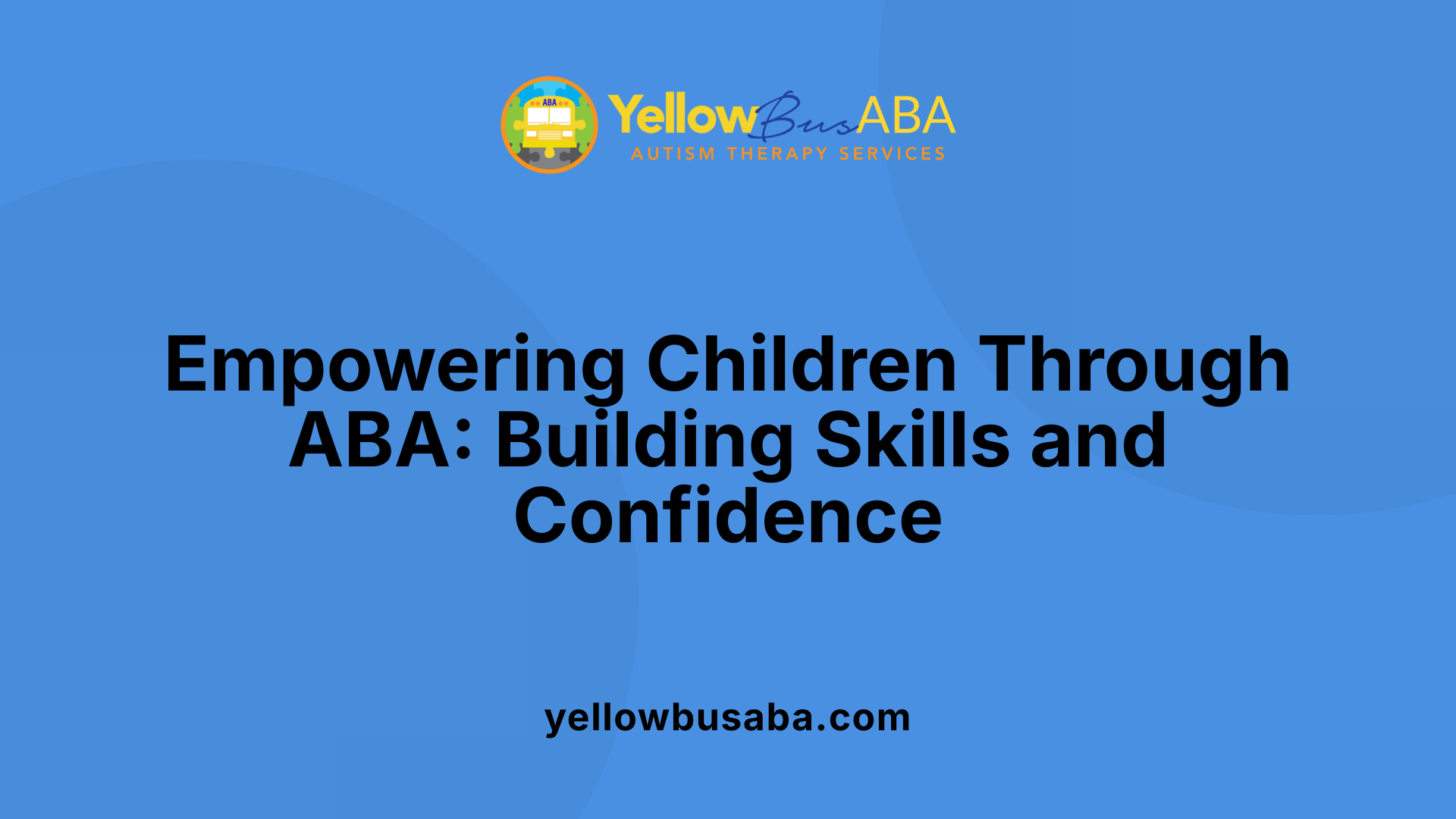The Benefits of Early Intervention for Children with Developmental Delays
October 29, 2025
Unlocking Potential: How Early Intervention Transforms Developmental Trajectories

The Critical Window of Early Childhood Development
Early childhood represents a unique period of rapid brain growth and neuroplasticity, making it an ideal time to address developmental delays. Timely identification and intervention can profoundly influence a child’s cognitive, social, and communication skills, setting the foundation for future success. For children with developmental delays such as Autism Spectrum Disorder (ASD), initiating therapies early dramatically improves long-term outcomes and quality of life.
Understanding Applied Behavior Analysis (ABA) Therapy

What is Applied Behavior Analysis (ABA) Therapy?
Applied Behavior Analysis (ABA) therapy is a science-based method used to promote positive social behaviors and reduce harmful ones, particularly in children with Autism Spectrum Disorder (ASD). Grounded in principles of behavioral science, ABA seeks to enhance communication, social interaction, cognitive skills, and self-care abilities by applying positive reinforcement techniques. This therapy carefully observes behaviors and their triggers to understand and modify them effectively.
Techniques Used Within ABA
ABA therapy employs various strategies such as analyzing antecedents, behaviors, and consequences (known as A-B-Cs) to inform interventions. Therapists use positive reinforcement to encourage desirable behaviors. Specific approaches include discrete trial training, naturalistic teaching methods, and functional communication training, all designed to build essential skills in a supportive manner.
Customization and Settings of ABA Therapy
Each ABA program is tailored to the child's unique needs following a comprehensive assessment by a qualified behavior analyst (BCBA). Goals are set across multiple skill domains, including communication, play, social skills, motor development, self-care, and academics. Therapy can be implemented in diverse environments such as the child's home, school, or community, ensuring consistency and relevance to daily life.
Evidence Supporting Early Intensive ABA Intervention
Substantial research supports the effectiveness of early intensive ABA therapy, especially when begun before age five. Studies indicate significant improvements in cognitive function, language skills, adaptive behaviors, and social interactions. Early ABA helps harness neuroplasticity, leading to more rapid and lasting developmental gains. Evidence from multiple studies and authoritative bodies like the US Surgeon General confirms ABA as a best practice for children with ASD, highlighting its role in fostering independence and improving quality of life.
How ABA Therapy Empowers Children with Autism and Developmental Delays

Behavioral improvements through ABA
Applied Behavior Analysis (ABA) therapy enhances behaviors in children with autism by promoting positive actions and decreasing problematic ones. Techniques such as positive reinforcement and analyzing behavior patterns help address issues like tantrums, aggression, and self-injury by understanding and modifying their root causes. This focused approach encourages desirable skills while reducing behaviors that interfere with learning and social interaction.
Skills targeted by ABA therapy
ABA therapy targets a broad spectrum of essential skills tailored to each child's needs. These include communication (both verbal and non-verbal), social interactions, self-care, play, motor skills, and academics. By fostering abilities such as eye contact, understanding social cues, and effective communication, ABA helps children navigate everyday situations more independently and confidently.
Methods and progress monitoring
ABA programs involve detailed assessments conducted by qualified behavior analysts (BCBAs) who set individualized goals. Therapists utilize structured activities, data collection, and ongoing observation to track progress. This methodical monitoring allows for timely adjustments, ensuring the therapy remains effective and aligned with the child's evolving needs.
Outcomes from early and intensive intervention
Starting ABA therapy early—often before age five and sometimes as young as age two—leverages the brain's neuroplasticity, resulting in significant improvements. Research shows that early intervention leads to enhanced cognitive abilities, language development, social skills, and adaptive behaviors. Children receiving intensive ABA therapy exhibit higher independence, better peer interactions, and reduced problematic behaviors, paving the way for improved long-term developmental outcomes.
Who Provides ABA Therapy and What Are Its Core Components?

Qualified providers of ABA therapy
ABA therapy is delivered by trained, licensed professionals specializing in applied behavior analysis. The primary providers include Board Certified Behavior Analysts (BCBAs), who oversee assessment and develop individualized treatment plans. Board Certified Assistant Behavior Analysts (BCaBAs) support BCBAs in implementing these plans. Additionally, Registered Behavior Technicians (RBTs) work directly with children under supervision, carrying out therapy sessions.
Clinicians with specialized ABA training may also provide services, ensuring quality care across various environments such as homes, schools, or community settings. Access usually begins with a formal diagnosis and insurance authorization to facilitate consistent therapy delivery.
Core elements of ABA therapy
ABA therapy revolves around detailed behavioral assessments to identify individual needs and goals across skill areas like communication, social interaction, self-care, and academics. Techniques include:
- Discrete trial training emphasizing systematic teaching of discrete skills
- Prompting strategies and positive reinforcement to encourage helpful behaviors
- Data collection to monitor progress
- Functional behavioral assessments to determine the causes of challenging behaviors
- Natural environment teaching to promote skills in real-life situations
Customization and implementation
Each child’s ABA program is tailored by the BCBA based on comprehensive assessments. Programs are dynamically adjusted to target critical developmental skills while addressing problem behaviors effectively. Therapists engage children in structured yet flexible activities to support generalization and maintenance of learned skills.
Family involvement and multidisciplinary collaboration
Family participation is integral, allowing caregivers to understand therapy goals and reinforce learning at home. Collaboration with other professionals like speech and occupational therapists enriches the intervention, ensuring holistic support addressing communication, daily living skills, and sensory needs alongside behavioral goals.
Together, these components form a structured yet adaptable framework, positioning ABA as a science-based, individualized, and collaborative approach designed to maximize outcomes for children with autism spectrum disorder.
The Unequivocal Benefits of Early Intervention for Developmental Delays

Timing of Intervention and Neuroplasticity
Early intervention leverages the remarkable neuroplasticity of the developing brain, particularly within the first few years of life. This period allows for maximum learning potential since the brain is highly adaptable. Initiating therapies such as Applied Behavior Analysis (ABA) before age five taps into this plasticity, promoting better developmental outcomes and skill acquisition.
Improvements in Cognitive, Language, and Social Skills
Evidence strongly supports that children with developmental delays, including those with Autism Spectrum Disorder (ASD), show significant gains when intervention starts early. Early ABA therapy enhances cognitive abilities, advances language development, and fosters social skills, including eye contact, understanding social cues, and meaningful peer engagement. These interventions facilitate faster acquisition of communication and adaptive behaviors critical for daily functioning.
Prevention and Reduction of Problem Behaviors
Early intervention not only builds positive skills but also prevents the entrenchment of challenging behaviors such as tantrums, aggression, or self-injury. ABA therapy analyzes behavior patterns and uses positive reinforcement to reduce these problem behaviors by addressing their root causes and teaching appropriate alternatives. This focus reduces barriers to social and functional participation.
Role of Speech and Occupational Therapy in Early Intervention
Complementing ABA, speech therapy improves speech production, language comprehension, and expressive abilities, leading to better social interaction and academic achievement. Occupational therapy assists children to master daily living skills, regulate sensory processing, and more actively participate in social environments. Together, these therapies support a holistic developmental approach.
Family Involvement and Comprehensive Support
Family engagement is essential for optimizing early intervention. Programs that involve parents equip them with strategies to support developmental progress at home. Comprehensive care, combining individualized therapy plans and collaborative service providers, ensures treatment is tailored to each child's unique needs, fostering confidence and independence.
| Aspect | Benefits of Early Intervention | Supporting Evidence and Notes |
|---|---|---|
| Neuroplasticity | Maximizes brain adaptability for better skill development | Critical during ages 0-5, enhances long-term learning |
| Cognitive & Language Skills | Significant improvements in understanding, communication, and social interaction | Backed by over 20 studies on ABA efficacy |
| Problem Behavior Management | Reduction in tantrums, aggression, and self-injury | ABA’s root cause analysis and positive reinforcement approach |
| Speech & Occupational Therapies | Speech: improved communication; OT: sensory and daily living skills | Integral to a multidisciplinary early intervention approach |
| Family & Comprehensive Support | Parental training and individualized plans improve developmental outcomes | Family involvement enhances home support and treatment consistency |
Effectiveness of ABA Therapy Across Diverse Needs and the Importance of Comprehensive Care

Evidence-Based Effectiveness of ABA
Applied Behavior Analysis (ABA) is widely recognized as an evidence-based intervention for children with Autism Spectrum Disorder (ASD). It improves critical areas such as communication, social skills, adaptive behavior, and decreases problematic behaviors through structured, data-driven methods. Over 20 studies affirm ABA’s effectiveness, especially when initiated early in childhood, with improvements documented in intellectual functioning, language development, and daily living skills.
Variability in Outcomes and Factors Influencing Success
While ABA therapy has demonstrated notable success, outcomes may vary across individuals. Effectiveness depends largely on tailoring treatment programs to meet each child’s unique needs and consistent implementation overseen by qualified behavior analysts (BCBAs). Age at therapy initiation, intensity, family involvement, and quality of services all influence results. Not all children experience the same degree of gains, highlighting the importance of flexible, individualized approaches.
Evolution Towards Naturalistic and Family-Inclusive Models
ABA therapy has evolved from foundational, highly structured models like the UCLA Young Autism Project to more naturalistic, developmentally sensitive approaches such as the Early Start Denver Model (ESDM) and the Learning Experiences: An Alternative Program (LEAP). These modern models emphasize active family participation and integrate therapy within everyday contexts, which enhances generalization of learned skills and supports more holistic development.
Integration of Therapies and Long-Term Impact
Optimal care for children with ASD often combines ABA with other therapies such as speech and occupational therapy. Speech therapy enhances communication—both verbal and nonverbal—while occupational therapy helps with sensory processing and daily living skills. Together with ABA, these combined approaches better address the diverse developmental needs of children, fostering greater independence and social competence over time.
Research Gaps and Future Directions
Although evidence supports ABA’s effectiveness, large-scale randomized controlled studies remain limited. Recent research calls for more standardized, long-term outcome measures, including quality of life assessments, to fully gauge therapy impact. Future studies are essential to strengthen the evidence base, inform clinical guidelines, and optimize personalized interventions for varying ASD profiles.
| Aspect | Description | Significance |
|---|---|---|
| Evidence-Based Success | ABA improves cognition, language, social skills, and reduces problem behaviors | Validates ABA as a cornerstone ASD treatment |
| Individual Variability | Success depends on personalized programs and intervention quality | Necessitates flexible therapy planning |
| Model Evolution | Shift towards naturalistic, family-inclusive approaches (ESDM, LEAP) | Enhances skill generalization and family engagement |
| Therapy Integration | Combines ABA with speech and occupational therapies | Addresses comprehensive developmental needs |
| Research Needs | Calls for more long-term, large-scale studies including quality of life | Guides future clinical practice and policy |
Maximizing Developmental Success Through Early Support
Early intervention is a powerful lever for improving the lives of children with developmental delays. Therapies like ABA harness the brain’s plasticity during critical early years to accelerate skills in communication, socialization, and independence. Delivered by qualified professionals and supported by engaged families, these personalized interventions reduce challenging behaviors and empower children to reach their full potential. As research continues to evolve, so too does our understanding of how best to tailor and combine therapies for lasting impact. Ensuring timely access to evidence-based early intervention remains essential in fostering brighter futures for children across the developmental spectrum.
References
- Why Referring for ABA Therapy at a Young Age Matters
- Applied Behavior Analysis (ABA)
- Why Early ABA Therapy is Crucial for Children with ASD
- The Importance of Early Intervention in Therapy | Bista
- Applied Behavior Analysis in Children and Youth with ...
- ABA Therapy for Children with Autism and Developmental ...
- Who can provide ABA therapy?
- Applied Behavior Analysis (ABA)





.jpg)
